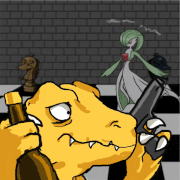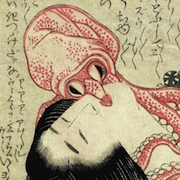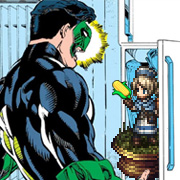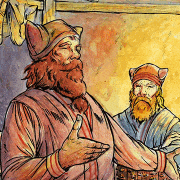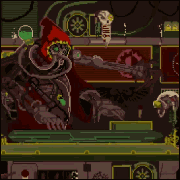|
that is also a discussion op. to ask if nostalgia is playing a part and pushing people to analyze what specifically makes them feel that way. otherwise its not a discussion its just various lists with the only responses being "yup. that was good."
|
|
|
|

|
| # ? May 9, 2024 21:50 |
|
that kind of thing tends to be a negative discussion because people will be pushed to defend themselves instead of defending the stuff they like.
|
|
|
|
Oh god I still have to make my list gently caressFeels Villeneuve posted:the whole "your favorite was when you were 16" talk annoys me, people are perfectly capable of critically looking at stuff lol Yeah I always hate that stuff. Or like "the only reason you like your favorite <X> is because it's the one you played when you were 12-16" or whatever, pick a series and an age and just run with it to dismiss any argument.
|
|
|
|
its called justifying not defending. it also seems like a salient point to make when specifically talking about the subject of the thread.
|
|
|
|
I do think that discussions like these are more interesting when people talk about not only which games were released that year, but also why those games matter, but I didn't want to require that in posts because I thought like three people total would've wanted to write an essay that long. It's why mine's taking so long 
|
|
|
|
I started writing the first of my posts (yes you heard that right) and oh no
|
|
|
|
2018 is a shoo-in because it saw the release of our sponsor Raid : Shadow Legends Use coupon code SCARODACTYL to get an exciting champion and 20% off your first purchase!
|
|
|
|
I don't know what that is, but as a 2018 voter I will take all comers. We need numbers for this movement. 2017 is gobbling up all our demographics. May I interest you voters in Yakuza Kiwami 2 and Yakuza 6? The Dragon engine? It is more floppy and physics-y, and has more detailed food simulation.
|
|
|
|
I opted to choose some years that I imagined would be overlooked otherwise... and 2017 but come on that year is just unfair. I put it at 2nd just to give it some humility. I ultimately tried to rank based on how many games from that year have stuck with me, which was hard because it's always a good year for games apparently, thanks for that OP now what am I supposed to complain about. Feels unfair to put an unfinished year in the top three but at this point it might as well be. Honourable Mention for 2022: Dorfromantik, Neon White, Strange Horticulture, Stray, Tunic, and Xenoblade Chronicles 3. Deserves a mention if only for the criminaly overlooked Titanfall 2 campaign. Honourable Mention for 2016: Dark Souls III, Dishonored 2, HITMAN, Picross 3D Round 2, Stardew Valley, SUPERHOT, Thumper, Titanfall 2, and XCOM 2. The return of DMC. Slay the Spire became the progenitor of a thousand steam games. Baba is You destroyed all our confidence in our intelligence. Honourable Mention for 2019: AMID EVIL, Apex Legends, Baba Is You, Control, Devil May Cry 5, Devotion, ISLANDERS, Manifold Garden, Outer Wilds, Slay the Spire, and Voxelgram.  #3 2011: Between Dark Souls, Minecraft, SpaceChem, Terraria, and Isaac... I'm not sure there's been a more influential year on game design since the 90s. That's also two of the best-selling games of all time, Minecraft with 238,000,000 units and Terraria with 44,500,000. Bastion | The debut from SuperGiant Games. Where they established everything they came to be known for: the solid gameplay, the vibrant art design, the unmatched music. Just a stone cold classic from the waning era of the original indie game boom. Portal 2 | I've always considered this a masterclass in game design, this tight little puzzle game with near perfect pacing and outstanding writing. I usually prefer games with flaws and jagged edges, things to get caught on and think about. But I can make room in my life for a game that's been refined to the nth degree. The Legend of Zelda: Skyward Sword | It is I, the Skyward Sword defender logging on. It's controls worked flawlessly for me, it's tutorialization just riding the line of my patience, but god everything else... flopping off of Skyloft for the first time just made me feel like a kid in a way I hadn't had in a decade. It has three of the best Zelda dungeons of all time and no lemons dragging it down, it's got sword fights with a long tongued man, it's got GROOSE. I just... adore it. Alongside: Alice: Madness Returns, Batman: Arkham City, Beyond Good & Evil HD, The Binding of Isaac, Bulletstorm, Dark Souls, Dead Rising 2: Off the Record, Dead Space 2, Deus Ex: Human Revolution, Driver: San Francisco, Ghost Trick: Phantom Detective, LIMBO, Minecraft, Rayman Origins, Saints Row: The Third, Sonic Generations, SpaceChem, Super Mario 3D Land, Superbrothers: Sword & Sworcery EP, Terraria, To the Moon, Uncharted 3: Drake's Deception.  #2 2017: If I was trying to approach this objectively, I'd be hard pressed to argue against 2017 being number one. Nintendo dropped arguably the best entries in their two biggest franchises alongside one of their most beloved consoles. PlayerUnknown's Battlegrounds came out, overtook CS:GO and DOTA2 in players, and we entered the era of battle royale games ruling over all. Hollow Knight, A Hat in Time, AND Night in the Woods all came out this year... it's insanity. NieR:Automata | Yoko Taro has always made memorable games, games that have an art and craft to them rarely seen. This is just the first time he made a game that fun to play as well. An RPG with Platinum combat... it's everything I ever wanted but never knew I could have. Bless this stunning, heartbreaking, and deeply horny game. Prey | Arkane made System Shock 3 and it's the best immersive sim. Hands down. Toe to tip it's this one, it took all of the groundwork laid in Dishonored and Arkane's earlier games then executed on them perfectly. Pyre | The black sheep of SuperGiant's catalog, overlooked and underplayed. The complete package their games always represent goes a long way to patching up some shaky at times gameplay but it's worth it for everything else. Alongside: A Hat in Time, Cuphead, Destiny 2, Dishonored Death of the Outsider, Divinity: Original Sin 2, The Evil Within 2, Guild Wars 2: Path of Fire, Heat Signature, Hollow Knight, Horizon Zero Dawn, Legend of Zelda: Breath of the Wild, Mario Kart 8 Deluxe, Metroid Samus Returns, Night in the Woods, Persona 5, PlayerUnknown's Battleground, Resident Evil 7: Biohazard, Shovel Knight Treasure Trove, Splatoon 2, STEAMWORLD DIG 2, Super Mario Odyssey, Tacoma, What Remains of Edith Finch, Wolfenstein II: The New Colossus, Xenoblade Chronicles 2, and Yakuza 0.  #1 2012: For me, 2012 has to take the cake. I was fresh to my twenties, after a few years of depression and isolation, earning money I could spend on tons of games and that's obviously casting a rose tint on these memories. But I've also sunk hundreds of hours into this crop of games and they're games I've come back to over and over again over the years. Dishonored | Arkane made Thief 4 and saved immersive sims in the process as far as I'm concerned. The world of Dunwall with it's Victorian architecture and whale oil powered generators, a world where you carve ruins into whale bone and promise yourself arcane gods for magic to call your own. It's like tolerable steampunk. Dragon's Dogma | The cult classic RPG of the 2010's. It's awkward, it's janky, and at times it's barely comprehensible. Yet everything about it gels into this ugly little masterpiece that sticks with you, it's a burr in your brain that'll never let go. Fire Emblem Awakening | I've played this game through five times, hundreds of hours leveling up Donnel. This was my comfort game when it came out. It also made Fire Emblem a real deal big boy franchise for Nintendo in the process. Mark of the Ninja | I'm not wholly convinced that Klei have ever made a bad game, but Mark of the Ninja is still their best. This is 2D stealth perfected. I geniunely think it's a perfect game. Xenoblade Chronicles | Xenoblade is just this perfectly addicting mix of JRPG and MMO. Sure it's at times derivative, babies first hero's journey but god is it ever charming with it's feast of UK accents helping these dumb kids be some of the most endearing protagonists in the genre. Alongside: Animal Crossing New Leaf, Binary Domain, Borderlands 2, Botanicula, Dark Souls: Artorias of the Abyss, Dear Esther, Defender's Quest: Valley of the Forgotten, Double Dragon: Neon, Dust: An Elysian Tale, Dustforce, FEZ, FTL, Guild Wars 2, Hotline Miami, Journey, LEGO The Lord of the Rings, Lollipop Chainsaw, New Super Mario Bros. 2, New Super Mario Bros U, Paper Mario: Sticker Star, Persona 4 Golden, Rhythm Heaven Fever, Skullgirls, Sleeping Dogs, Spec-Ops: The Line, Sonic & All-Stars Racing Transformed, Spelunky, Stacking, Thirty Flights of Loving, Thomas Was Alone, Tokyo Jungle, The Walking Dead (Telltale), XCOM Enemy Unknown and Zero Escape: Virtue's Last Reward.
|
|
|
|
The Year of the Game: A Statistical Analysis When it comes down to deciding the Year of the Game, i.e. the best year for video gaming, there are many factors that must be taken into account. In order to be truly confident of a result every year must be given suitable consideration. After all every year has produced great, important video games that have defined the industry. Over the course of my posts I will display to you a precisely-worked mathematically-defined analysis that will confirm with complete certainty which year is the Year of the Game. Methodology In order to judge the merits of a year’s gaming output we must first define the scope of this analysis. For us to assess each year fairly it is essential to assess an equal number of games across every year. It was decided that ten would be a suitable number of games to examine, this number both allowing for a wide breadth of selection without genre blindness while still ensuring that only the highest quality of games are included in the analysis. The ten games representing each year were selected based on a combination of critical acclaim and long-term impact on the industry. Each game was then assigned a rating between one and ten and these scores were averaged out to provide a final rating for the year as a whole. Once we have examined every year we will be able to say with absolute definitiveness which year is the Year of the Game. Where to Begin However before we can dive into the analysis there is one critical question that must be answered: at what point do we start our analysis? The very first video game was Tennis For Two made in 1958 so we can immediately discount every preceding year. So should we start in 1958? Well while we can provide a rating for Tennis For Two there was not even a video game industry at this point. As our analysis is designed to assess the state of the industry it stands to reason we can move past this year as well as 1962’s Spacewar! and 1971’s Computer Space. The video game industry was truly born in 1972 with the release of Pong so should this be our starting point? For the purposes of our methodology we must discount any year which did not produce 10 video games of merit and while Pong is certainly influential the year did not produce enough games of quality to be in contention. This also eliminates 1977’s Space Invaders and 1979’s Asteroids. 1980 would be a definite contender as a start point with the rise of Pac-Man however there are still not quite enough games of worthy value to be counted. Instead we will begin with 1981 as the arcade scene hits the height of its powers. 1981 Yes, 1981 can be viewed as the peak of the Golden Age of Gaming. The arcade scenes were thriving with a vast collection of important titles and no genre was better served than the shmup with genre-defining titles like Defender (6), Galaga (7) and Scramble (4). There was also space to play with the shooter concept as the likes of Tempest (8) and Centipede (4) experimented with the formula to much success. However the arcades were also a space for invention with the likes of Frogger (5) and Qix (6) providing fresh, innovative concepts. Namco followed up their monster smash of 1980 with Ms. Pac-Man (7) and a new face arrived on the scene as Nintendo released their first game, Donkey Kong (8). But gaming wasn’t just in the arcades. The home computing scene was still in its infancy hindered by technical limitations but there was still nuggets of gold to be found, none more so than Richard Garriott’s Ultima (3).  1982 Everything was running smoothly in 1982 as the arcade scene continued to flourish thanks to the likes of Q*Bert (5), Xevious (6) and Robotron 2084 (4). After years of shooter saturation the industry was beginning to look for new sources of inspiration with Dig Dug (4) and Mr. Do! (4) both delving deep while Gravitar (4) and Choplifter (5) looked to the stars and Joust (3) was mostly just clucking about. Away from the arcades the Atari 2600 was in many a child’s home bolstered by the likes of Pitfall! (2) and home computing was the place to look for text adventures including Melbourne House’s genre-pushing The Hobbit (5). Indeed, the video game industry was riding high. Nothing could go wrong from here…  1983 Oh no, it’s all gone a bit Pete Tong! The one-two blow of Pac-Man and E.T. on the 2600 caused by Atari’s ineptitude had devastating impact through the industry, not only bringing the company to its knees but destroying confidence in the market leading to the famous Video Game Crash. But never fear, there was still time for the arcade to see Spy Hunter (6), Crystal Castles (6) and Track and Field (4). The industry needed a saviour and perhaps that would be Laserdisc, a new technology spearheaded by the release of Dragon’s Lair (2) although this would prove too costly to produce to be viable. With the arcades collapsing it was up to home computing to carry the load with big releases like Ultima III (3) and Lode Runner (2). Infocom had already established themselves as the #1 source for text adventures but this was the year they released one of their best, Planetfall (8). Gaming had also come to the UK where the ZX Spectrum and Commodore 64 were providing computers at an affordable price that the everyday family could pick up. Untethered to the American scene British developers were exploring new directions such as Manic Miner (4) and Jetpac (3) from Ultimate Play The Game, the company that would one day become Rare. Oh, and over in Japan it was also a busy year for Nintendo who released Mario Bros. (4) while also finding time to produce a new console, the Famicom. I’m sure that’ll never amount to anything though.  1984 With the industry still reeling from the Video Game Crash it was a tough year for gaming but there were still nuggets of gold to be found in the arcades such as Marble Madness (8) and Duck Hunt (4). It was a good year for martial arts fans as Kung-Fu Master (5) and Karate Champ (4) set up the base concepts of the fighting genre. Across the Atlantic the UK scene was well insulated from the effects of the crash and beginning to churn out classic hits such as early platformer Jet Set Willy (4) and the first ever space-sim, Elite (6). Computer owners in America were not without joy either thanks to Spy vs. Spy (5). Adventure gaming continued to go to strength to strength as Infocom produced The Hitchhiker’s Guide to the Galaxy (7) but they were joined on the scene by Sierra who’s breakthrough hit King’s Quest (5) added new graphical scope to the genre. Meanwhile there was a big to-do happening behind the Iron Curtain as people argued over who was responsible for creating the block-falling puzzler that would come to be known as Tetris (10). There wasn’t much to speak of on console, however. With the fall of Atari the industry needed a new standard bearer.  1985 Things are always darkest before the dawn and in 1985 the sun rose on the gaming industry as Nintendo launched the NES in America on the back of Super Mario Bros. (10). Sure, it was only a limited release in a small part of the country for now but the key words there were ‘for now’. Life was also returning to the arcades where Japan was carrying the load thanks to Konami’s Gradius (9), Sega’s Space Harrier (6) and Capcom’s Ghosts n’ Goblins (7) and even Atari proved they weren’t dead quite yet with Gauntlet (7) and Paperboy (4). The martial arts trend was continuing apace with Yie-Ar Kung Fu (6) while Rambo inspired the start of the run-and-gun trend with Commando (5). There were also big steps in the sports genre as Tekhan World Cup (6) laid the groundwork for football games. With all this it was a somewhat quiet year for home computing but Richard Garriott continued his run of success with Ultima IV (5) and a company called Microsoft released the first iteration of Windows. Yes, video gaming had been saved and was definitely alive. Now it was time for it to thrive.  1986 After years of being on the bubble video gaming exploded as the NES went live across the United States and Nintendo weren’t stopping there. To support their new console they produced The Legend of Zelda (10) and Metroid (8), a pair of games wide in scope with vast worlds to explore and secrets to uncover. The console was also beginning to see support from third-party developers leading to key releases like the first JRPG Dragon Quest (7) and the franchise-spawning Castlevania (8). But over in Japan the NES was suddenly facing competition as Sega’s Master System was beginning to take off thanks to hits like Alex Kidd in Miracle World (5). Sega was also keeping up their focus on the arcades where bold graphics and killer music made OutRun (7) the first great racing game. Other top games to hit the arcades this year included Arkanoid (6), Salamander (8) and Bubble Bobble (5). In the adventure genre Infocom continued their string of success with Trinity (7) but graphical advances were about to herald the end of the text adventure.  1987 With the NES continuing to fly off the shelves all that was left for developers to do was continue to produce classic games for the console which they did with Mega Man (8) and Contra (7). There was also top first party support from Nintendo with Mike Tyson’s Punch-Out (8) being the big release in America while in Japan they produced Doki Doki Panic (8), the game that would later go on to be known as Super Mario Bros 2 in the west. But the most important NES release of the year undoubtedly came from a struggling company known as Squaresoft with their last gasp attempt to stay solvent, Final Fantasy (8). The Master System was not without its big games either with Shinobi (6) being the cream of the crop. In the arcades R-Type (7) pushed the shmup to new heights and Double Dragon (7) laid the groundwork for the beat em up genre. On home computers LucasArts created the SCUMM Adventure engine and with Maniac Mansion (8) began one of the greatest series of game releases of all time. And last but certainly not least in Japan a little known game designer released a game for a little known platform and in doing so Hideo Kojima’s Metal Gear (8) heralded the beginnings for one of the industry’s best producers. It was only going to go up from here.  1988 It was a case of more of the same for the industry in 1988 as developers continued to break new ground from the capabilities of the NES. Franchises were being well established by the likes of Mega Man 2 (9) and Final Fantasy II (5) but nothing on the NES could match Nintendo’s own Super Mario Bros 3 (10). The now renamed Rare hit their first classic in RC Pro-Am (8) while Ninja Gaiden (6) drove players batty with its legendary difficulty. It was also a good year in the arcades for beat-em-ups with Splatterhouse (6) and Altered Beast (6) both making a splash. Meanwhile in the land of PCs Pool of Radiance (6) provided CRPG fans the DnD experience they had been craving and LucasArts continued to establish themselves as the new kings of the adventure with Zak McKraken and the Alien Mindbenders (6). While he was still to discover the mass market appeal of a major console Hideo Kojima was back on his bullshit with Snatcher (7). All in all the 2nd generation of gaming had hit its prime, gaming was the best it could ever possibly be. Or was it?  1989 While the NES had been a huge success there were rumblings from within Nintendo that there could be something even better. Something super, perhaps, but that would be a story for another day. With their own attention diverted it was up to others to maintain the NES’s status as brand leader and releases like DuckTales (7) and Castlevania III (7) did their fair share to carry the weight. Sega’s Master System had fallen off the pace over the last couple of years but in Wonder Boy III: The Dragon’s Trap (8) the console finally had a killer app. Arcades continued to flourish with support from Golden Axe (6) and Final Fight (8) while on PC developers were still discovering new genres as Peter Molyneux created the god game in Populous (8) and Will Wright brought us the city builder with SimCity (9). There were also new advances in animation as Prince of Persia (8) introduced the use of rotoscoping to gaming. The UK gaming scene had fallen from grace as the popular Commodore Amiga lacked support from devs but Shadow of the Beast (6) gave owners something to get excited about.  1990 Just when everyone thought they had the console market cornered Nintendo decided to take things one step further with the brand new SNES. 8-bit was out, 16-bit was in – that’s twice as many bits! But a console is nothing without games and games they had with Super Mario World (10),F-Zero (9) and ActRaiser (8) providing a visual feast for the eyes and a tough challenge for the hands. There were still a last few breaths to come from the NES however as Final Fantasy III (8), Dr. Mario (6) and Mega Man 3 (8) saw the console out in style. The hits continued to come from LucasArts who really started to hit their stride with The Secret of Monkey Island (10) and elsewhere on PC Wing Commander (7) brought bright, bold action to the space-sim genre. Hideo Kojima continued to explore the boundaries of gaming and cinema with Metal Gear 2 (9) and in arcades Smash TV (7) proved to be an, erm, smash. A new decade had arrived and with it new technology and big new opportunities for the industry.  The Results: 1981 – 1990 After our first ten years we are left with the following results:  1. 1990 (8.2) 2. 1987 (7.5) 3. 1989 (7.4) Will these scores hold up as we dive full force into the 90s? Only time will tell
|
|
|
|
so much data....... 
|
|
|
|
lol, holy poo poo Rarity
|
|
|
|
O
|
|
|
|
M
|
|
|
|
G
|
|
|
|
|
|
|
|
Them's some gooooooood charts.  How were the scores assigned? Personal opinion, initial popularity, lasting power? Synthetic Hermit fucked around with this message at 22:11 on Aug 25, 2022 |
|
|
|
Synthetic Hermit posted:Them's some gooooooood charts. A combination of first-hand experience, second-hand experience, commercial success, critical success and importance to the industry as a whole. Obviously I cannot divulge the explicit formula but be assured this a serious and comprehensive scientific analysis
|
|
|
|
Rarity posted:A combination of first-hand experience, second-hand experience, commercial success, critical success and importance to the industry as a whole. Obviously I cannot divulge the explicit formula but be assured this a serious and comprehensive scientific analysis A strong set of variables. 
|
|
|
|
The Legend of Zelda is a jrpg
|
|
|
|
Good to see King's Quest on there, but my loves are Space Quest and Quest for Glory! They got rolling in 86 and 89 respectively. Mega Man, just typing those words grants one a certain je ne sais quoi, much love for ol' Rock.
|
|
|
|
Rarity posted:All in all the 2nd generation of gaming had hit its prime, gaming was the best it could ever possibly be. Or was it? '88 is firmly 8-bit, so 3rd Gen I'd say edit; amazing post tho, if I didn't already properly say BeanpolePeckerwood fucked around with this message at 23:59 on Aug 25, 2022 |
|
|
|
BeanpolePeckerwood posted:'88 is firmly 8-bit, so 3rd Gen I'd say Oops I didn't read Wikipedia properly
|
|
|
|
Rarity posted:Will these scores hold up as we dive full force into the 90s? Only time will tell
|
|
|
|
yeah, this is an understatement. i can't wait to see which games are selected to represent each year
|
|
|
|
The Year of the Game: A Statistical Analysis – Part 2 When we left off these were the scores on the doors: 1. 1990 (8.2) 2. 1987 (7.5) 3. 1989 (7.4) However we’ve entered a new era of gaming in the 90s as technological improvements mean we can expect bold cartoon graphics and more expansive game worlds. Let’s see how this effects our results! 1991 With the SNES finding immediate success Sega were put under the cosh. They needed to strike back in the console wars in a big way with their new hardware, the Genesis. More than that they needed a character that could match up to everyone’s favourite plumber to prove that Sega did what Nintendidn’t. Enter a brash blue hedgehog who just gotta go fast as Sonic the Hedgehog (9) became a system seller. The age of the video game mascot had begun. Faced with the strongest challenge yet to their supremacy the SNES fired back with huge updates to beloved franchises like Final Fantasy IV (9), Super Castlevania IV (8) and the seminal Legend of Zelda: Link to the Past (10). And just as everyone was packing away their NES consoles they were pulling them back out for Tecmo Super Bowl (7). For the more discerning gamer PCs were providing a space for games that stretched the mind as much as the reflexes. LucasArts showed no signs of stopping with Monkey Island 2: LeChuck’s Revenge (10) and DMA Design made their first mark on the industry with Lemmings (8) but perhaps most important of all was the latest invention of Sid Meier: a game focused on exploration, expansion, exploitation and extermination called Civilization (8). Not to say that action-focused gamers were completely deprived on PC as Another World (7) broke new ground in cinematic gameplay. However the most important release of the year may well have been in the arcades where flashy special moves and a global flair made Street Fighter II (10) an immediate attention-grabber. The arcades were dying out as home gaming became more and more affordable but they weren’t going out without a (quite literal) fight.  1992 While the hearts and minds of many a child were wrapped up in the console wars things were different for PC gamers where they were getting the kinds of games that could never hope to fit on a console. Whether it was SNES or Genesis neither could ever hope to handle brand new genres like the RTS Dune II (7), the survival horror Alone in the Dark (5) or the first-person shooter Wolfenstein 3D (6). Or for those drawn to more traditional genres LucasArts continued to bat a thousand with Indiana Jones and the Fate of Atlantis (8). Not that this mattered to the Sega and Nintendo fans, however, as arguments raged in the playgrounds. For every Sonic the Hedgehog 2 (10) there was a Super Mario Kart (8) and for every Final Fantasy V (9) there was a Shining Force (8) or a Streets of Rage 2 (8). Peace would only be called temporarily for trips to the arcade where Mortal Kombat (7) was making all the wrong kind of headlines for its philosophy that everything was better with blood. Throughout its existence the gaming industry had been able to live in a wild west where anything went but gaming was becoming big business and the eyes of the world were starting to take note.  1993 Developers in the realm of PC continued to thrive with creativity, none more so id Software who’s shareware release strategy turned Doom (10) into a global phenomenon that put the FPS genre on the map, although it did little to stem the tide of controversy brewing over violent games. The proliferation of CD-ROMs had led to a rise in the use of FMV with Myst (7) and The 7th Guest (5) showing the potential of the technology although this would prove to be a dead end in innovation. Elsewhere Maxis stepped things up a level with SimCity 2000 (9) and LucasArts showed they were more than just a one trick pony with Star Wars: X-Wing (7). Console gamers also had to lot to enjoy with SNES owners getting Star Fox (7) and Secret of Mana (8) while Treasure brought Gunstar Heroes (8) to Genesis fans. While football fans of both varieties were well served the same had never been true for basketball fans until Midway brought NBA Jam (8) to the arcades. And in a hitherto underserved corner of the market handheld gaming finally received its first vital release as Legend of Zelda: Link’s Awakening (10) shrunk all the magic of a Hyrule adventure into the Game Boy.  1994 Four years on from its initial release the SNES was now well into its lifespan and game designers were pulling the absolute peak from its infrastructure. Whether it was the lush graphics of Donkey Kong Country (9) or the vast worlds of Final Fantasy VI (10) the SNES was showing unlimited potential. But none were unleashing that potential more than Nintendo themselves who released the double barrel shot of Super Metroid (10) and Earthbound (10). Not that Genesis owners would be left too far behind as Sonic the Hedgehog 3 (8) launched with a whole other game in its cartridge. Another cartoon mascot made his debut as Earthworm Jim (6) brought its own unique, irreverent tone. Fighting games continued to be the last hope of the arcades as Killer Instinct (9) focused on combo while Tekken (8) showed the possibilities that could be delivered by cutting edge 3D engines. However the furore over violent games had reached its peak leading to the establishment of the ESRB to provide suitable age ratings. One of the first games on their docket? The follow-up to id’s groundbreaking hit, Doom II (8). They would have been less worried about Beneath A Steel Sky (8), a game which proved more than just LucasArts could succeed in the adventure genre. Indeed, as PCs became more and more capable of delivering tight action experiences the heyday of the point-and-click was fast coming to an end.  1995 Another genre that was starting to take off on PC was the RTS as Command and Conquer (8) kickstarted a major franchise and Warcraft II (9) began a string of hits that would turn small-time studio Blizzard into one of the most important game companies in the world. In the land of consoles it was a great time to be a JRPG fan as Chrono Trigger (10), Terranigma (8) and Secret of Evermore (8) made the genre as good as it has ever been while those searching for a more thoughtful experience had much to find in Tactics Ogre (9). For those who weren’t fans of the genre there was still gold to be found as Super Mario World 2: Yoshi’s Island (10) and Donkey Kong Country 2 (10) delivered a pair of polished platforming experiences. The Genesis had fallen off the pace as Sega focused on its new console, the Saturn, but Comix Zone (8) still gave owners something to get excited about. However in a shocking twist the main challenger to Nintendo’s crown in the new generation would not come from Sega at all. No, that would come from Sony who entered the market with the PlayStation. The clear standout from their launch titles was Wipeout (8) with trippy music and exhilarating gameplay that deliberately targeted older teens. Video games were growing up.  1996 With the PlayStation and Saturn already on the shelves it was time for the next generation to kick-off in full swing as Nintendo pushed beyond their 32-bit competitors with the Nintendo 64, a console which surprisingly enough had 64-bits. All this power under the hood took gaming into a new dimension with Super Mario 64 (9) and Pilotwings 64 (8) leading the way into 3D worlds. Sony was not to be left behind in this new space however as the PlayStation got Crash Bandicoot (8) and Tomb Raider (8) while Resident Evil (8) took the survival horror genre into the mainstream. Although the Saturn was not quite able to match par in tech NiGHTS Into Dreams (9) gave owners one of the most unique games of all time. Meanwhile in its last days the SNES was still churning out JRPG smashes as Super Mario RPG (9) combined the genre with gaming’s greatest franchise. Nintendo were riding so high that even the Game Boy was thriving as Pokémon Red/Blue (10) started a worldwide marketing sensation. Over on PC Blizzard introduced the world to loot grinders with Diablo (7) and id’s Quake (9) inspired owners to get together in massive numbers to play multiplayer at LAN parties. All the way back from Pong gaming had always been a social experience but now it was bringing people together like never before.  1997 A new generation of consoles may have taken over the market but the console wars showed no signs of slowing down. On one side stood the N64 which saw another major franchise update in Star Fox 64 (8) while Rare began arguably the best ever combination of console and developer with Goldeneye 007 (10) and Blast Corps (8). On the other side stood the PlayStation who’s switch to CD technology was swaying the eye of many a developer resulting in many franchises jumping sides such as Castlevania: Symphony of the Night (9) and Final Fantasy VII which took an epic story and sweeping visuals to bring JRPGs into the West. But the PSX was also introducing new names that would go on to great success in the industry as Grand Theft Auto (8) and Gran Turismo (7) both saw the first entries in their respective series. As ever the PC scene continued to breed fresh ideas as Fallout (9) combined a post-apocalyptic setting and broad player choice to spearhead a movement in isometric CRPGs while Age of Empires (7) added a new flavour to the RTS genre. There was also room for old favourites with Riven (8) gave puzzle fans many a difficult night. But if it seemed like the video game industry was in a good place it was about to hit a whole new gear…  1998 By the late 90s the video game industry was running at full tilt with quality pouring from every quarter. It seemed like no matter your choice of platform there were masterpieces waiting directly for you. N64 gamers were eagerly tearing into The Legend of Zelda: Ocarina of Time (10), PlayStation fans were shaking in fear at the sight of Resident Evil 2 (10) and PC owners were clicking their fingers off with Starcraft (10). Seekers of high octane thrills could find their home in F-Zero X (9) and those looking for more illicit action could get their kicks with Thief: The Dark Project (8). It had been a while since LucasArts had hit their heights of their best adventure games but they had one last gem inside them as they put out Grim Fandango (9). As one falls another must take its place and stepping into the limelight this year was Valve who’s innovative use of in-game cutscenes provided an immediacy of storytelling that made Half-Life (9) a must have purchase. They weren’t the only ones giving great stories as Xenogears (9) combined JRPGs with classic mech fiction but they would be overshadowed by another mech as Hideo Kojima returned from years in the wilderness with Metal Gear Solid (10), which blurred the lines between movie and video game. Yes it was a great time to be a gamer and it showed no signs of slowing down.  1999 After more than a decade at the top of the mountain the unthinkable was occurring. Nintendo’s supremacy had been overturned as difficult console infrastructure was turning developers away in droves in favour of Sony’s less powerful but more capable hardware. The PSX would continue to see hit after hit as Final Fantasy VIII (9), Silent Hill (7) and Legacy of Kain: Soul Reaver (9) all came out to high acclaim. Nintendo were also under threat in the other direction as Sega put the Saturn behind them and came back with the first 128-bit console in the Dreamcast which was garnering many headlines for the captivating world of Shenmue (8). However Nintendo were still kings of handheld market where the Game Boy Color was making waves and Pokémon Gold/Silver (10) added a number of exciting new features to the original’s gameplay. On PC RTSs continued to be well served with Age of Empires II and Planescape: Torment (10) took storytelling in games to new levels. By now PCs had well established themselves as the home of FPSs but now the genre was expanding into multiple new directions as System Shock 2 (10) focused on an immersive single-player story while Unreal Tournament (8) fed the never-ending bloodlust for multiplayer deathmatches. But if while single-player was one thing and multiplayer was another, something new was brewing in the works. Something massive. The concept of MMOs had been around since the MUDs of the 80s but it was the release of Everquest (8) that brought the genre into prominence as its addictive grind kept gamers hooked for months. It was a model of which many would soon be taking note.  2000 The N64 had taking some heavy hits in the latest iteration of the console wars but as Sony launched their next console, the PS2, they gave up centre stage. With the spotlight assured Nintendo responded with The Legend of Zelda: Majora’s Mask (10) and called in support from Rare with Perfect Dark (10). However there was still one last classic to come from the PSX and what a classic it was as Final Fantasy IX (10) dropped and instantly became a benchmark for the series. Despite its power the Dreamcast was still struggling to establish itself but Skies of Arcadia (10) and Jet Set Radio (8) were strong arguments in its favour. The streams of gold weren’t just spared for console owners as PC gamers also saw their share of greatness. Trusted developers continued to deliver as Blizzard kept up their strong run with Diablo II (9), Maxis took the simulation genre in a whole new direction with The Sims (8) and Valve brought teamwork to the multiplayer FPS with Counter-Strike (8). But they weren’t the only ones making waves as BioWare established themselves and their Infinity Engine as one to watch with Baldur’s Gate II (10). It was a new millennium, a time of new possibilities and no game captured the mood more than Deus Ex (10), a game much touted for its freedom and responsiveness to player choice. The barriers were crumbling, the laws of game design were breaking down, the future was untold possibility.  The Results: 1991 – 2000 So here’s where we stand after our next decade:  The eagle eyed among you will notice that we have a tie at the top with both 1998 and 2000 on equal scores. In this situation we will settle the standings on the countback rule, 2000 has 6 games on a perfect 10 compared to 1998’s 5 which edges it out at the top. There’s also a tie in third place so the same rule was applied, leaving us with: 1. 2000 (9.4) 2. 1998 (9.4) 3. 1999 (8.8) Three consecutive years lead the way at the top, what a time indeed to be a gamer! Will this go down as the peak period of gaming or will a new contender await in the 00s? We will have to find out another day Rarity fucked around with this message at 06:30 on Aug 27, 2022 |
|
|
|
wow that was fast
|
|
|
|
BeanpolePeckerwood posted:wow that was fast I had up to 98 written up, was going to do the last 2 years tomorrow but I saw your posts and thought sure why not 
|
|
|
|
the N64 was effectively a 32 bit console, it had a 32 bit front side bus that bottlenecked everything. nintendo made a genius PR move tho calling it the N64 because number go up equals mo'betta and this image induces pure unfiltered sense memory within me  half-life is a 10 tho BeanpolePeckerwood fucked around with this message at 00:24 on Aug 27, 2022 |
|
|
|
Half-Life is one of my fav things ever, and Action Half-Life is my most played game of all time. So for multi and mods alone I'd go with a 10. For single player I could see a 9, I think it's kinda known that HL1 is front loaded, a lot of people lose interest somewhere before the end of the campaign. But still, one of the greats.
|
|
|
|
I think you forgot Day of the Tentacle. Literal GOAT and a 13/10 game.
|
|
|
|
I really shoulda got my post in earlier, I can’t follow Rarity! I mean I’m honor bound to, and yet… Also drat 1998 and 2000 coming in strong, huh?
|
|
|
|
Harrow posted:I really shoulda got my post in earlier, I can’t follow Rarity! I mean I’m honor bound to, and yet… If you get it in now you'll be smack dab in the middle of Rarity's posts, which ticks all the boxes of honor, deference, hype, nostalgia, and shitposting compulsion And I don't think Rar has even played the games of the 2010s yet so you can always hope that the results will be deadlocked interminably 
|
|
|
|
Very surprised to see Rarity bucking the mainstream trend and putting Majora's Mask and Perfect Dark on an even keel with Ocarina of Time and Goldeneye.  Commercial success appears to have low weighting. Commercial success appears to have low weighting.Small typo; in the writeup, Age of Empires doesn't have its score (7, going by the chart) next to it.
|
|
|
|
I told y'all that 97-2003 was The Golden Age and Rarity's scientific methodology is proving me right Rarity is MVP btw
|
|
|
|
Ms Adequate posted:I told y'all that 97-2003 was The Golden Age and Rarity's scientific methodology is proving me right 1995-2003 is popularly considered the golden age of 3D gaming, it's pretty uncontroversial considering 'golden age' is fundamentally a retrospective term.
|
|
|
|
the golden age is now
|
|
|
|
Using Rarity's system can we figure out the shittiest gaming year now?
|
|
|
|
late 16-bit and late ps4/switch era are my favs op
|
|
|
|

|
| # ? May 9, 2024 21:50 |
|
Feldegast42 posted:Using Rarity's system can we figure out the shittiest gaming year now? my gut tells me it has to be one of the later years in gen 7 where they were pushing both motion gaming and 3D tvs on us or 2021
|
|
|






